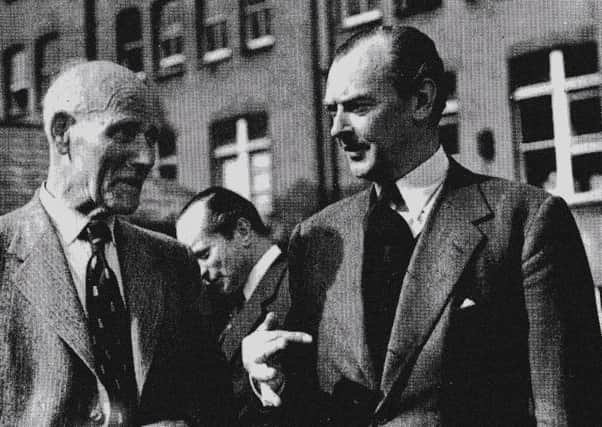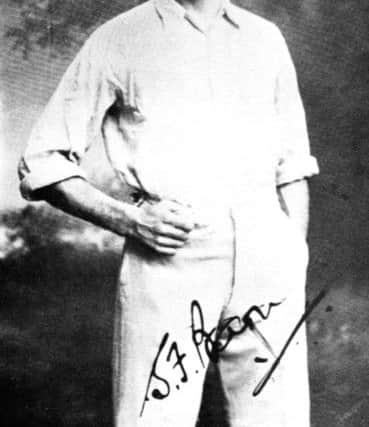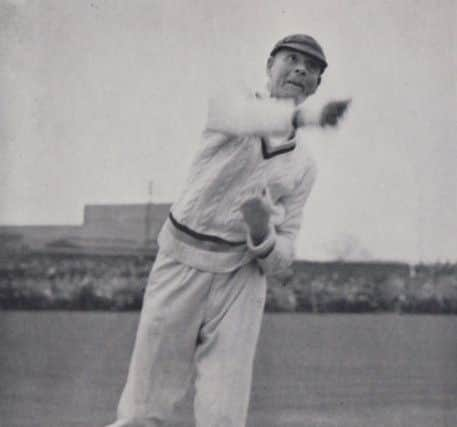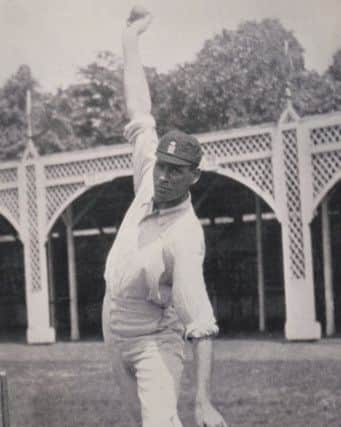Story of 'England's greatest ever bowler' who played for St Annes


Despite preferring the life of a peripatetic league professional and playing only 45 first class games, he totally dominated the game throughout the first half of the 20th century and last year marked 50 years since his death. His performances at every level of the game, including a season at Highbury Road as the St Annes professional in 1937, make unprecedented reading.
All this came against the backdrop of an illicit adulterous liaison, that could so easily have brought a premature end to his sporting career.
Advertisement
Hide AdAdvertisement
Hide AdSomething of a saturnine figure, whose somewhat gaunt face had what Sir Jack Hobbs famously described as, a death or glory expression, Sydney Francis Barnes was born in Smethwick on April 19 1873, the second son of a sheet metal worker.


Largely uncoached, his early cricketing experiences came at his local club. He made four appearances for Warwickshire between 1894 and 1896, enjoying only moderate success. Unimpressed by the opportunities available at Edgbaston, league cricket would prove more than adequately suited both to his temperament and his pocket.
Six feet tall, lean and lithe, and with an easy approach to the wicket, Barnes was a right arm fast medium bowler of immense stamina. A high, upright action enabled him to extract life from the deadest of wickets. Superbly fit and exercising immense control, his best delivery was a fast leg break that pitched on leg and moved away to the off.
Good length and late swing played a huge part in his success. When conditions were in his favour, he took his triumphs almost perfunctorily with a self-assurance that assumed success a mere formality. He dominated, then despatched.
Advertisement
Hide AdAdvertisement
Hide AdFor the 1895 season, Barnes moved north to play for Rishton in the Lancashire League. Signing for £3.10s per week, amid five seasons with the club, in 1898, he successfully bowled them to the championship title. With Barnes in full flow they once went 12 matches without ever having more than 80 runs to get for victory. In 1900, he moved to Burnley, his 114 wickets bringing home the league title 12 months later. Moving to Church in 1904, the league title duly arrived the following year. Five years earlier he had also made his debut for Lancashire versus Sussex at Hove.


In 1901, after an impressive net session at Old Trafford bowling to AC Maclaren, the England captain chose Barnes as one of his team to tour Australia, the only non-first class player in the party. Making his test debut at Sydney in December of that year, he took 5-65 and 1-74, his first victim being the great Victor Trumper. In the second match, he ended with a match analysis of 13-163.
Disappointingly, a troublesome leg injury sadly curtailed his progress. Despite his many triumphs, he played only once in 1902, being on the losing side against the Australians in the Sheffield Test.
On his return to England, at the behest of Maclaren, and despite a niggling knee injury, Barnes accepted terms with Lancashire as a full- time professional. In his first full season, 1902, he took 82 first class wickets, while in his second, he ended it with 131 victims.
Advertisement
Hide AdAdvertisement
Hide AdUpset at being forced to become the proverbial workhorse, bowling in excess of 1,000 overs per season, single-minded as always, he fell out with the Lancashire committee when they declined to find him the promised winter employment, or guarantee him a benefit match against Yorkshire.


It was while at Old Trafford Barnes made headlines of a different kind – being cited, in 1902, as a co-respondent in a somewhat messy divorce action brought by Birmingham clerk, George Taylor.
Having first met Alice Taylor at a ball in the city, the couple then set up home together. Amid a widely reported court case, in which Barnes pleaded with Taylor for leniency to help salvage his cricketing career, he was eventually fined £300.
He and Alice subsequently married, the union lasting 41 years until Alice’s death in 1944. Their only son, Francis Leslie, was born in 1904.
Advertisement
Hide AdAdvertisement
Hide AdThat same year, he began a long and productive 31-year association, playing for Staffordshire in the Minor Counties Championship.
Having claimed a record-breaking 119 wickets during the 1906 season, in what was the first of six championship titles, the following year at Wakefield he took all 10 Yorkshire wickets. Never a novice with the bat, against Durham at South Shields in 1911, having ended with a match bowling analysis of 17 wickets for 80 runs, he went on to score 136. With 1,441 victims for the county, Barnes remains the competition’s leading career wicket taker of all time.
Eventually recalled to the England team for the 1907/8 tour of Australia, his 24 wickets increased his test match tally to 50 in just nine appearances. He added 17 more in three matches against Australia in England the following summer, and his 34 wickets on the tour of 1911/12, helped inflict on the hosts their biggest ever defeat on home soil. As always, he retained a unique ability to step-up from league and minor counties cricket and bowl out all the great batsman of the day.
During the 1912 Triangular Tournament involving South Africa and Australia, he claimed no fewer than 39 wickets.
Advertisement
Hide AdAdvertisement
Hide AdHowever, his greatest bowling performance in test matches came in South Africa in 1913-14, his final overseas trip. Unplayable on the matting wickets then in use, in just four appearances and, at the age of 40, his 49 wickets, included 17 in one memorable encounter in Johannesburg.
Selected to tour Australia for the fourth time in 1920/21, at the age of 47, he declined when his family were not allowed on the trip. Taking five wickets in an innings on no less than 23 occasions, his 189 wickets had come in only 27 test matches. Only seven test batsmen ever scored centuries against him.
Having taken 893 wickets during his nine years as club professional for Porthill Park in the North Staffordshire League, in 1915, deemed too old for military service, Barnes moved to Saltaire in the Bradford League. Claiming eight wickets for eight runs on his debut, in the next encounter against Keighley, he once again he took all 10 wickets, his analysis including five victims in five balls.
Over the next nine years he never failed to top both the league batting and bowling averages. Ending his best season, 1922, with 122 wickets, helped propel his side to their fourth league title in six years.
Advertisement
Hide AdAdvertisement
Hide AdHis later career would take in Castleton Moor and Rochdale in the Central Lancashire League, Rawtenstall in the Lancashire League, Bridgnorth and with Keighley in the Bradford League.
In 1935, Barnes returned to the Midlands, again creating new league records during two seasons with Smethwick. His league career eventually ended three years later at Stone in the North Staffs and South Cheshire League. Throughout 45 continuous years of involvement in club cricket, his final tally of 4,069 wickets came at an average of 6.08.
Eighty-one years ago Barnes was engaged as a professional by St Annes Cricket Club, then members of the Ribblesdale League.
That season, at the age of 64, he would bowl more than 500 overs and take 61 wickets at an average of 12.47.
Advertisement
Hide AdAdvertisement
Hide AdPartnering him in opening the attack was another Sydney, this time the former Essex all-rounder, Sydney Puddlefoot.
A left arm medium pace bowler and right-handed middle order batsman, Puddlefoot was also a former England football international.
An inside forward who played for West Ham, Falkirk and Blackburn Rovers.
When transferred form West Ham to Falkirk in 1922, he became the first footballer to be sold for £5,000.
Advertisement
Hide AdAdvertisement
Hide AdIn tandem with his sporting career, when a young man, Barnes spent many years working as a clerk in the Staffordshire coalfield.
He later took-up residence in North Wales, acting as mine host of Colwyn Bay’s Royal Hotel. While there, he also made occasional appearances for Wales. In later years, compiling legal documents, he worked as a calligrapher for Staffordshire County Council. When still in work at the age of 84, in 1957 he was tasked with preparing and presenting a specially created handwritten scroll to Queen Elizabeth II to commemorate her historic visit to the county.
In later life, now warmly embraced by the very establishment he once so despised, Barnes became one of the first professional cricketers to be elected honorary members of MCC. A similar honour was bestowed upon him from Staffordshire County Cricket Club. That same year, 1953, still coaching throughout the county, he was granted a testimonial, 62 years after his debut for Smethwick.
On April 26, at Stafford Cricket Club, an England XI took on Sydney Barnes’s XI. Aged 80, still slim, Barnes bowled the opening over of the match to Jack Ikin.
Advertisement
Hide AdAdvertisement
Hide AdFriendship with such luminaries as Pelham Warner and Sir Neville Cardus confirmed Barnes’s star status and it was Cardus himself who, in 1963, named him as one of his Six Giants of the Wisden Centenary. Subsequently immortalised in verse by Alan Ross, his career also becoming the subject of a stage play, while today, his impressive portrait proudly adorns the hallowed portals of Lord’s.
Active to the end, he died at his Staffordshire home on December 26, 1967, aged 94.